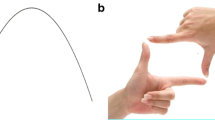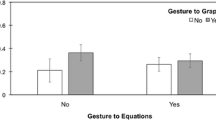Abstract
This paper provides an exposition of the unfolding and growing complexities of student and instructor gesturing over time. Specifically, it provides an account of how different forms of gestures, all related to the same mathematical idea, can create a chain of signs that support and enhance increasingly sophisticated understanding of one important concept in the learning of differential equations. The chain of gestures presented in this paper offers researchers, instructors, and instructional designers a view of the way in which different gestures can form a common conceptual thread. Expanding on Walkerdine’s (1988) theory of chains of signification, gestures are framed as signs in a chain of signification that captures the evolution of the idea over an extended period of time. Data for the analysis comes from a semester-long classroom teaching experiment in a first course in differential equations.














Similar content being viewed by others
Notes
All student names are pseudonyms.
References
Alibali, M., & DiRusso, A. (1999). The function of gesture in learning to count: more than keeping track. Cognitive Development, 14, 37–56.
Alibali, M., & Goldin-Meadow, S. (1993). Gesture–speech mismatch and mechanisms of learning: what the hands reveal about a child’s state of mind. Cognitive Psychology, 25, 468–523.
Alibali, M. W., & Nathan, M. J. (2007). Instructors’ gestures as a means of scaffolding students’ understanding: evidence from an early algebra lesson. In R. Goldman, R. Pea, B. Barron, & S. J. Derry (Eds.), Video research in the learning sciences. Mahwah, NH: Erlbaum.
Arzarello, F., & Edwards, L. (2005). Gesture and the construction of mathematical meaning. Proceedings of PME XXIX, Melbourne, vol. 1, pp. 122–145.
Broaders, S. C., Cook, S. W., Mitchell, Z., & Goldin-Meadow, S. (2007). Making children gesture brings out implicit knowledge and leads to learning. Journal of Experimental Psychology, 136(4), 539–549.
Cassell, J. (2000). Nudge nudge wink wink: elements of face-to-face conversation for embodied conversational agents. In J. Cassell, J. Sullivan, S. Prevost, & E. Churchill (Eds.), Embodied conversational agents (pp. 1–27). Cambridge, MA: MIT Press.
Cobb, P. (2000). Conducting teaching experiments in collaboration with instructors. In A. E. Kelly & R. A. Lesh (Eds.), Handbook of research design in mathematics and science education (pp. 307–334). Mahwah, NJ: Lawrence Erlbaum.
Cobb, P., Gravemeijer, K., Yackel, E., McClain, K., & Whitenack, J. (1997). Symbolizing and mathematizing: the emergence of chains of signification in one first-grade classroom. In D. Kirshner & J. A. Whitson (Eds.), Situated cognition theory: social, semiotic, and neurological perspectives (pp. 151–233). Hillsdale, NJ: Erlbaum.
Gravemeijer, F. K., Bowers, F. J., & Stephan, M. (2003). Continuing the design research cycle: a revised measurement, arithmetic instruction sequence. In M. Stephan, J. Bowers, P. Cobb, and K. Gravemeijer (Eds.), Journal for Research in Mathematics Education. Monograph, Supporting Students’ Development of Measuring Conceptions: Analyzing Students’ Learning in Social Context, Vol. 12 (pp. 103–122). Reston, VA: National Council of Teachers of Mathematics.
Hadar, U., & Butterworth, B. (1997). Iconic gestures, imagery, and word retrieval in speech. Semiotica, 115, 147–172.
Halliday, M. A. K. (1978). Language as social semiotic: the social interpretation of language and meaning. London: Edward Arnold.
Hostetter, A. B., & Alibali, M. (2008). Visible embodiment: gestures as simulated action. Psychonomic Bulletin and Review, 15(3), 495–514.
Hostetter, A. B., Bieda, K., Alibali, A. W., Nathan, M. J., & Knuth, E. J. (2006). Don’t just tell them, show them! Instructors can intentionally alter their instructional gestures. In R. Sun & N. Miyake (Eds.), Proceedings of the 28th Annual Conference of the Cognitive Science Society (pp. 1523–1528). Mahwah, NJ: Erlbaum.
Keene, K. A. (2007). A characterization of dynamic reasoning: reasoning with time as parameter. The Journal of Mathematical Behavior, 26, 230–246.
Lacan, J. (1977). Ecrits: a selection. London: Tavistock.
Lakoff, G., & Nunez, R. (2000). Where mathematics comes from. New York, NY: Basic Books.
Lampert, M., & Cobb, P. (2003). White paper on communication and language. In J. Kilpatrick, D. Shifter, & G. Martin (Eds.), Principles and practices of school mathematics: research companion volume (pp. 237–249). Reston, VA: National Council of Instructors of Mathematics.
Markovits, Z., Eylon, B., & Bruckheimer, M. (1986). Functions today and yesterday. For the Learning of Mathematics, 6(2), 18–28.
McNeill, D. (1992). Hand and mind: what gestures reveal about thought. Chicago, IL: The University of Chicago Press.
McNeill, D. (2000). Catchments and contexts: non-modular factors in speech and gesture production. In D. McNeill (Ed.), Language and gesture (pp. 312–328). Cambridge: Cambridge University Press.
Monk, S. (1992). Students’ understanding of a function given by a physical model. In G. Harel & E. Dubinsky (Eds.), MAA notes, vol. 25. The concept of function: aspects of epistemology and pedagogy (pp. 175–193). Washington, DC: Mathematical Association of America.
Morgan, C. (2006). What does social semiotics have to offer mathematics education research? Educational Studies in Mathematics, 61, 219–245.
Nemirovsky, R., Tierney, C., & Wright, T. (1998). Body motion and graphing. Cognition and Instruction, 16, 119–172.
Pea, R. D. (1993). Practices of distributed intelligence and designs for education. In G. Solomon (Ed.), Distributed cognition (pp. 47–87). New York: Cambridge University Press.
Rasmussen, C. (2001). New directions in differential equations: a framework for interpreting students’ understandings and difficulties. The Journal of Mathematical Behavior, 20, 55–87.
Rasmussen, C., & Kwon, O. (2007). An inquiry oriented approach to undergraduate mathematics. The Journal of Mathematical Behavior, 26, 189–194.
Rasmussen, C., Yackel, E., & King, K. (2003). Social and sociomathematical norms in the mathematics classroom. In H. Schoen & R. Charles (Eds.), Teaching mathematics through problem solving: grades 6–12 (pp. 143–154). Reston, VA: National Council of Instructors of Mathematics.
Rasmussen, C., Nemirovsky, R., Olszewski, J., Dost, K. and Johnson, J. (2004). On forms of knowing: the role of bodily activity and tools in mathematical learning. Educational Studies in Mathematics, 57.
Rasmussen, C., Stephan, M., & Allen, K. (2004). Classroom mathematical practices and gesturing. The Journal of Mathematical Behavior, 23, 301–323.
Reynolds, F. J., & Reeve, R. A. (2002). Gesture in collaborative mathematical problem-solving. The Journal of Mathematical Behavior, 20, 447–460.
Roth, W. (2001). Gestures: their role in teaching and learning. Review of Educational Research, 71, 365–392.
Sfard. (1991). On the dual nature of mathematical conceptions: reflections on processes and objects as different sides of the same coin. Educational Studies in Mathematics, 22, 1–36.
Sfard. (1992). Operational origins of mathematical objects and the quandary of reification––the case of function. In E. Dubinsky (Ed.), The concept of function: aspects of epistemology and pedagogy (MAA notes #25) (pp. 59–84). Washington, DC: Mathematical Association of America.
Sfard. (2001). There is more to discourse than meets the ears: looking at thinking as communication to learn more about mathematical learning. Educational Studies in Mathematics, 46, 13–57.
Strauss, A. L., & Corbin, J. M. (1998). Basics of qualitative research: techniques and procedures for developing grounded theory. Newport Park: Sage.
Varela, F. J., Thompson, E., & Rosch, E. (1991). The embodied mind: cognitive science and human experience. Cambridge, MA: MIT Press.
Vinner, S., & Dreyfus, T. (1989). Images and definitions for the concept of function. Journal for Research in Mathematics Education, 20, 356–366.
Walkerdine, V. (1988). The mastery of reason: cognitive development and the production of rationality. London: Routledge.
Yackel, E., & Rasmussen, C. (2002). Beliefs and norms in the mathematics classroom. In G. Leder, E. Pehkonen, & G. Toerner (Eds.), Beliefs: a hidden variable in mathematics education? (pp. 313–330). Dordrecht: Kluwer.
Zandieh, M., & McDonald, M. (1999). Student understanding of equilibrium solution in differential equations. In F. Hitt & M. Santos (Eds.), Proceedings of the 21st Annual Meeting of the North American Chapter of the International Group for the Psychology of Mathematics Education (pp. 253–258). Columbus, OH: ERIC.
Acknowledgments
Support for this paper was funded in part by the National Science Foundation under grant no. DRL 0634074. The opinions expressed do not necessarily reflect the views of the foundation.
Author information
Authors and Affiliations
Corresponding author
Rights and permissions
About this article
Cite this article
Keene, K.A., Rasmussen, C. & Stephan, M. Gestures and a chain of signification: the case of equilibrium solutions. Math Ed Res J 24, 347–369 (2012). https://doi.org/10.1007/s13394-012-0054-3
Received:
Revised:
Accepted:
Published:
Issue Date:
DOI: https://doi.org/10.1007/s13394-012-0054-3




